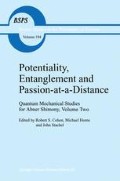Abstract
In his book More Than One Mystery,1 Mark Silverman takes issue with Feynman’s claim that “in reality it [the phenomenon of electron self-interference] contains the only mystery [of quantum mechanics]2. Silverman objects that: “As one directs attention away from systems of single particles to systems of correlated particles or particles and space together, other mysteries equally profound arise”, going on to list three such phenomena in support of his claim that:
There is more than one mystery in the singular and intriguing world of quantum mechanics:
-
1)
The counter-intuitive, long range influence of one object on another, such as first underscored by Einstein;
-
2)
The perplexing (from the standpoint of interpretation) physical influence of spatial topology in the nonlocal interaction of charged matter with electromagnetic fields, as emphasized by Aharonov and Bohm;
-
3)
The strange connection between spin and statistics...
Access this chapter
Tax calculation will be finalised at checkout
Purchases are for personal use only
Preview
Unable to display preview. Download preview PDF.
References
Bose, Satyendra Nath (1924), “Plancks Gesetz und Lichtquantenhypothese”, Z. Phys. 26, 178–181.
Dittrich, Walter and Reuter, Martin (1994), Classical and Quantum Dynamics from Classical Paths to Path Integrals, 2nd ed. ( Berlin/Heidelberg, Springer-Verlag).
Einstein, Albert (1916), “Strahlungs-Emission und-Absorption nach der Quantentheorie”, Deutsche Physikalische Gesellschaft ( Berlin ). Verhandlungen 18, 318–323.
Einstein, Albert (1924a), “Über den Ather”, Schweizerische naturforschende Gesellschaft. Verhandlungen 105, 85–93.
Einstein, Albert (1924b), “Quantentheorie des einatomigen idealen Gases”, Preussische Akademie der Wissenschaften (Berlin). Physikalisch-mathematische Klasse. Sitzungsberichte, 261–267.
Einstein, Albert (1925), “Quantentheorie des einatomigen idealen Gases. Zweite Abhandlung”, Preussische Akademie der Wissenschaften (Berlin). Physikalisch-mathematische Klasse. Sitzungsberichte, 3–14.
Einstein, Albert, Podolsky, Boris, and Rosen, Nathan (1935), “Can Quantum-mechanical Description of Physical Reality Be Considered Complete?”, Phys. Rev. 47, 777–780.
Feynman, Richard P. (1948), “Space-time approach to non-relativistic quantum mechanics”, Rev. Mod. Phys. 20, 367–387.
Feynman, Richard (1985), QED: The Strange Theory of Light and Matter (Princeton, Princeton University Press).
Feynman, Richard P., Leighton, R.B. and Sands, M. (1968), The Feynman Lectures on Physics, vol. 3 ( Reading, MA, Addison-Wesley ).
Howard, Don (1990) “ ‘Nicht sein kann was nicht sein darf,’ or the Prehistory of EPR, 1909–1935: Einstein’s Early Worries About the Quantum Mechanics of Composite Systems”, in Arthur Miller, ed. Sixty-Two Years of Uncertainty ( N.Y., Plenum Press ), pp. 61–111.
Kleinert, Hagen, (1990), Path Integrals in Quantum Mechanics Statistics and Polymer Physics ( Singapore, World Scientific).
Laidlaw, Michael and Morette deWitt, Cecile (1971), “Feynman Functional Integrals for Systems of Indistinguishable Particles”, Phys. Rev. D 3, 1375–1378.
Leinaas, J.M. and Myrhein, T. (1977), “On the Theory of Identical Particles”, Nuovo Cimento, 37B, 1–23.
Mehra, Jagdish (1994), The Beat of a Different Drum: The Life and Science of Richard Feynman ( Oxford, Clarendon Press).
Schulman, Lawrence (1968), “A Path Integral for Spin”, Phys. Rev. 176, 1558–1569.
Shimony, Abner (1989a), “Conceptual Foundations of Quantum Mechanics”, in Paul Davies, ed., The New Physics (Cambridge/New York/New Rochelle/ Melbourne/Sydney,Cambridge University Press), pp. 373–395.
Shimony, Abner (1989b), “Search for a Worldview which Can Accommodate our Knowledge of Microphysics”, in James T. Cushing and Ernan McMullin, eds., Philosophical Consequences of Quantum Theory ( Notre Dame, IN, Notre Dame Press ), pp. 25–37.
Silverman, Mark P. (1993), “More than One Mystery: Quantum Interference with Correlated Charged Particles and Magnetic Fields”, Am. J. Phys. 61, 514–523.
Silverman, Mark P. (1995), More than One Mystery: Explorations in Quantum Interference ( New York/Berlin: Springer-Verlag).
Sinha, Sukanya and Sorkin, Rafael (1991), “A Sum-Over-Histories Account of an EPR(B) Experiment”, Found. Phys. Lett. 4, 303–335.
Stachel, John Jay (1982), “Globally Stationary but Locally Static Space-times: A Gravitational Analog of the Aharonov-Bohm Effect”, Phys. Rev. D 26, 1281–1290.
Stachel, John Jay (1986a), “Do Quanta Need a New Logic?”, in Robert G. Colodny, ed., From Quarks to Quasars: Philosophical Problems of Modern Physics ( Pittsburgh, PA, University of Pittsburgh Press ), pp. 229–347.
Stachel, John Jay (1986b), “Einstein and the Quantum: Fifty Years of Struggle”, in ibid., pp. 349–385.
Stachel, John Jay (1993), “The Other Einstein: Einstein Contra Field Theory”, Science in Context 6, 276–290.
Stachel, John Jay (1994), “Bose and Einstein”, in Partha Ghose and Abhijit Mookerji, eds., Bose and 20th Century Physics (forthcoming).
Author information
Authors and Affiliations
Editor information
Editors and Affiliations
Rights and permissions
Copyright information
© 1997 Springer Science+Business Media Dordrecht
About this chapter
Cite this chapter
Stachel, J. (1997). Feynman Paths and Quantum Entanglement: Is There Any More to the Mystery. In: Cohen, R.S., Horne, M., Stachel, J. (eds) Potentiality, Entanglement and Passion-at-a-Distance. Boston Studies in the Philosophy of Science, vol 194. Springer, Dordrecht. https://doi.org/10.1007/978-94-017-2732-7_19
Download citation
DOI: https://doi.org/10.1007/978-94-017-2732-7_19
Publisher Name: Springer, Dordrecht
Print ISBN: 978-90-481-4809-7
Online ISBN: 978-94-017-2732-7
eBook Packages: Springer Book Archive

